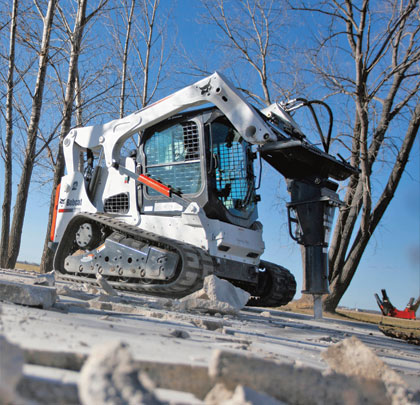Whether you’re a longtime compact track loader owner/operator, or are in the market to enhance your equipment fleet and offerings, there is no question that matching the machine to the job should be a top consideration. It’s a first step that will offer increased efficiency and uptime, as well as easy regular maintenance. In addition, compact track loader attachment options offer versatility that’s hard to match.
“It used to be that you either had a very large machine or a shovel, but nothing in between,” says Mike Fitzgerald, Bobcat loader product specialist. “Compact equipment, like track loaders, makes an operator’s job immensely more efficient and eliminates a lot of manual labor.”
FEATURES AND BENEFITS
When choosing a compact track loader, be sure to let the dealer know exactly what the machine will be used for. Do you need something that fits well in tight spaces, or do you have plenty of room on new construction sites? Are you picking up material and loading it into a truck, requiring extra lift and reach, or are you doing final grading work? These are all important parameters that help a dealer best understand your needs.
Lifting performance is one of the most important factors to evaluate. Larger track loaders are engineered with a higher-rated operating capacity, allowing them to handle heavier loads of aggregates and palletized materials, such as brick and blocks or bags of cement sand. If that’s what you move on a daily or weekly basis, then lifting capacities must be analyzed, Fitzgerald says.
When it comes to lift arm design, some manufacturers offer a choice between loaders with a vertical lift path and a radius lift path. A vertical lift path loader provides higher lift capacity and more reach at full lift height than a radius lift path machine. Because maximum reach is achieved at full lift height, a vertical lift path loader makes it easier to clear high-sided trucks and hoppers, and perform jobs that require repeated lifting at taller heights. While a vertical path loader may have a higher initial cost, its utilization and resulting job profitability could be better for your particular operation, and these machines usually command higher resale prices.
A radius lift path loader, on the other hand, raises the load in an arc that provides maximum reach at truck bed height. A radius lift path machine excels at jobs with mid-range or lower working heights, like dumping material over a wall, backfilling, loading and unloading flatbed trucks, and leveling or grading.
The length and width of a compact loader’s tracks have a direct effect on ground pressure and traction. Narrow tracks provide better traction and maximize ground pressure on hard surfaces or slippery ground. Contractors may consider a wide-track option to lower ground pressure and increase floatation when working in wet, muddy, or sandy conditions.
It’s also important to assess the value of high-flow hydraulics for track loaders and attachments that can benefit from an extra power boost. “If an attachment makes up a significant portion of your operational time, it increases your productivity and your overall return to have machines and attachments with high-flow hydraulics capabilities,” Fitzgerald says.
The environment the machine will be working in is another important consideration, including dust and debris in the summer or cold, snowy conditions in the winter. Pressurized cabs provide the operator excellent protection from the elements, while maintaining a comfortable temperature inside the cab. The new Bobcat® M-Series loaders offer the operator increased comfort features, as well as a unique cab-forward design that moves the operator closer to the attachment and provides unmatched visibility in all directions.
BEST PRACTICES
When it comes to operation and maintenance of a skid steer loader, “It’s always best to first and foremost follow the manufacturer’s instructions that come with the machine,” Fitzgerald says. “Match the machine to the job. Don’t try to load the bucket beyond its rated capacity. If you’re using hydraulically powered attachments like a breaker, be sure the auxiliary flow is within the appropriate range for the breaker.”
Following the recommended operation and preventive maintenance guidelines will ensure a machine performs efficiently and hopefully ward off any unscheduled repairs, minimizing costs. Machine performance varies based on who is operating the equipment, so Fitzgerald suggests that if a foreman or owner notices one person operating more effectively versus another, to find out what the differences are and implement those efficiencies when training new operators.
In addition to daily fluid-level checks and visual checks of the machine and attachment components, examining undercarriage components is an equally important maintenance item. Most manufacturers’ idlers and rollers are permanently sealed and lubricated; however, they—along with sprockets and tracks—may need to be replaced periodically depending on a machine’s use. The cost of rubber tracks typically ranges from $3,000 to $4,500 per set and will last 1,200 to 1,600 hours. “The occasional track tensioning can be done with a common grease gun, and tracks can be replaced in less than an hour on some machines,” Fitzgerald says.
ATTACHMENT VERSATILITY
The breadth of attachments also provides the option of year-round operation and enables the operator to utilize the compact track loader in various applications through low initial investment with great return. If a one-off job opportunity comes along, it’s easy to rent an attachment, and in most applications compact equipment coupled with attachments works as well or better than dedicated machines.
“Compact equipment can do 80 percent of the work,” Fitzgerald says. “You can make a profit as long as you have the machines and attachments to complete the job.” ■
For More Information:
Article supplied by Bobcat Company headquartered in West Fargo, North Dakota. For more information, visit www.bobcat.com.
_________________________________________________________________________
Modern Contractor Solutions, September 2013
Did you enjoy this article?
Subscribe to the FREE Digital Edition of Modern Contractor Solutions magazine.

Sizing Up Compact Track Loaders For Optimal Performance


